|

 Up
Up 
 1906-1912
1906-1912
Vertical-4 Engine 
(You are here.)



  Need
to Need
to
find your
bearings?
Try
these
navigation aids:
If
this is your first
visit, please stop by:
Something
to share?
Please:



|
|
Available in Française, Español, Português, Deutsch, Россию,
中文,
日本, and others.
 nitially
designed in 1906, the Wrights used these 240 cubic-inch motors on
their commercial airplanes through 1912. Delivering 30-40 hp, these
engines had a gear-driven high-tension magneto and distributor with
spark plugs. This ignition system is still common in piston airplane
engines. The operator adjusted the spark timing with a hand-lever on
the magneto, later with foot pedal. Each of cast-iron vertical
cylinders bolted onto the aluminum crank case. A water pump
circulated coolant through the cylinders and a radiator, but only half the
area of each cylinder was cooled. Like the
1904-1905 motors, the fuel pump delivered gasoline directly to the intake manifold
– there was no carburetor or
throttle. The pilot opened a compression release to aid starting and to shut off the motor
in flight. nitially
designed in 1906, the Wrights used these 240 cubic-inch motors on
their commercial airplanes through 1912. Delivering 30-40 hp, these
engines had a gear-driven high-tension magneto and distributor with
spark plugs. This ignition system is still common in piston airplane
engines. The operator adjusted the spark timing with a hand-lever on
the magneto, later with foot pedal. Each of cast-iron vertical
cylinders bolted onto the aluminum crank case. A water pump
circulated coolant through the cylinders and a radiator, but only half the
area of each cylinder was cooled. Like the
1904-1905 motors, the fuel pump delivered gasoline directly to the intake manifold
– there was no carburetor or
throttle. The pilot opened a compression release to aid starting and to shut off the motor
in flight.
The motors were rated at 28 horsepower when they were
first introduced, but this gradually increased to 40 as the Wright
Company made improvements. The motor became known as the Wright 4-40
– 4 cylinders, 40 horsepower. It was regarded for its reliability,
although there were common problems with the failure of exhaust
valves, pistons, and cylinders.
This was the only motor which the Wrights
licensed other companies to produce –
copies were made in France, England, and Germany.. Although their competitors had more powerful
motors, the Wrights' motor were more reliable. And when coupled with the
Wright's efficient
bent-end propellers, they produced more thrust.
Carillon Park in Dayton, OH. displays one of these motors.
Specifications:
- Cylinders: 4
- Bore: 4-3/8 in (11.1 cm)
- Stroke: 4 in (10.2 cm)
- Displacement: 240 in3 (3.9 l3)
- Horsepower: 28 to 40
- Ignition: Spark plugs powered by high-tension Mea or Bosch
magneto.
- Weight: 160 lbs (72.6 kg) dry
- Unique features: Compression release, fuel injection,
auxiliary exhaust ports in cylinders
References:
- McFarland, Marvin W. (ed) The papers of Wilbur and Orville Wright. McGraw-Hill
Book Co., New York, 1953, p 1215-1216, plates 227-228.
- Hobbs, Leonard S. The Wright Brothers' Engines and Their design. Washington, D.C.:
Smithsonian Institution Press, 1971, pp 34-46.
- Lippincott, Harvey H. Propulsion System of the Wright Brothers. In Wolko, Howard S.
(editor), The Wright Flyer, an Engineering Perspective. The Smithsonian Institution Press,
1987, pp 87-89.
[Submitted by Joe W. McDaniel]
|
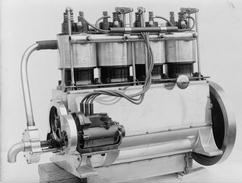
The left side of a vertical 4-cylinder Wright engine.
The magneto (lower left) had an internal distributor to fire the
spark plugs in the proper sequence.
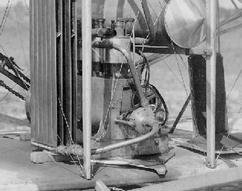
The Wright 4-40 installed in a Model AB, showing the centrifugal
water pump attached to the front of the engine.
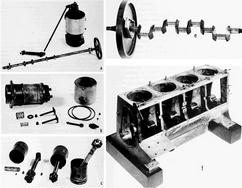
The engine block (lower right), crankshaft (upper
right) and other parts of a Wright 4-40 engine.
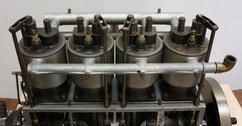
Close-up of a Wright 4-40 engine, showing the four in-line cylinders.
Like previous Wright engines, the exhaust valves were operated by
cams and rocker arms, while the intake valves were "automatic"
– spring-operated.
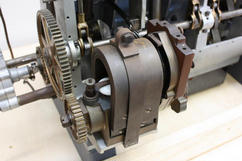
A detail of the Magneto and magneto drive.
|
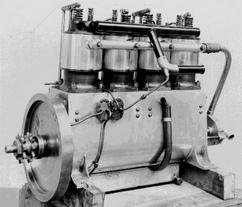
The right side of the Wright 4-40 engine. The two small oval shapes
attached to the crankcase were pumps –
one pumped oil, the other fuel. There was no carburetor; the fuel
pump served as a form of fuel injection.
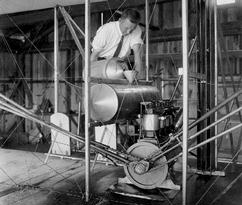
A student pilot, Arch Hoxsey, fills the fuel tank. We're looking at
the rear of the Wright 4-40 where the propeller drive chains are
attached.
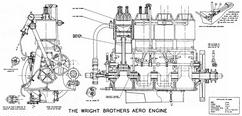
Front and side views of a Wright vertical 4-cylinder engine.
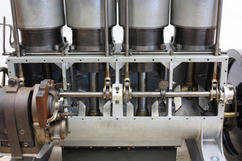
The crankcase with the cover removed, showing the cam shaft.
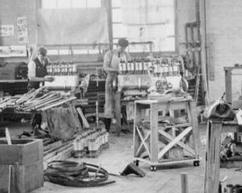
Workmen assemble Wright 440 engines in the Wright factory in 1911.
|